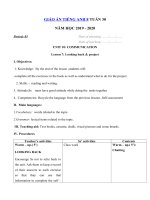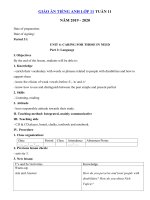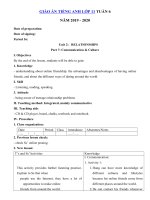Tải Giáo án tiếng Anh lớp 8 Tuần 26 sách mới - Giáo án điện tử môn tiếng Anh 8 theo tuần
Bạn đang xem bản rút gọn của tài liệu. Xem và tải ngay bản đầy đủ của tài liệu tại đây (157.75 KB, 17 trang )
<span class='text_page_counter'>(1)</span><div class='page_container' data-page=1>
<i><b>mẫu miễn phí</b></i>
<b>GIÁO ÁN TIẾNG ANH 8</b>
<b> TUẦN 26</b>
<b>NĂM HỌC 2019 - 2020</b>
<i><b>Period: </b><b> 73</b><b> Date of planning: ……/……/……</b></i>
<i> Date of teaching: ……/……/……</i>
<b>UNIT 9: NATURAL DISASTER</b>
<b>Lesson 5: Skills 1</b>
<b>I. Objectives: </b>
<b>1. Knowledge: By the end of the lesson ,students will be able to :</b>
- Read for general and specific information about how to prepare for a natural
disaster..
- Talk about natural disasters and ways to prepare for them.
<b>2. Skills: Reading, speaking </b>
3. Attitude:Ss must have good attitude towards facing natural disaster
<b>4. Competencies: Coping with disasters </b>
<b>II. Main languages: </b>
<i>1.Vocabulary: essential wreak havoc destructive guidelines emergency</i>
<i>2.Grammar: </i>
<b> III. Teaching aid: lesson plan , visual pictures</b>
<b>IV. Procedures</b>
<b>Teacher’s activities</b> <b>Ss’ activities</b> <b>Contents</b>
<b>Warm – up.( 5’)</b>
- Before Ss open their books, ask
<i>the question: ‘What can we do to </i>
Class work <b>Warm – up.( 5’): </b>
</div>
<span class='text_page_counter'>(2)</span><div class='page_container' data-page=2>
<i><b>mẫu miễn phí</b></i>
<i>prepare for a natural disaster?’</i>
<i>- See if any Ss can come up with </i>
some ideas.
- Make notes on the board.
- As an option, this could be done
in Vietnamese with T showing
how to express these ideas in
English.
- Now have Ss open their books.
<b>Pre-reading(10’)</b>
<b>1- Read an article about how to </b>
<b>prepare for a natural disaster. </b>
<b>Look at the words in the box, </b>
<b>then find them in the article and </b>
<b>underline them. What do they </b>
<b>mean?</b>
- Ask Ss to scan the article to find
<i>where the words/phrases wreak </i>
<i>havoc, essential, destructive, </i>
<i>guidelines, and emergency are in </i>
the article.
- Ask if Ss know the meaning of
the words/ phrases.
- If they do not, T may help Ss
work out the meanings of these
words from the article.
Individual work <i><b>Suggested answers: </b></i>
<i>- Wreak havoc: do great </i>
damage or harm to
somebody/ something.
<i>- essential: necessary.</i>
<i>- destructive: causing </i>
major damage, from the
<i>verb destroy.</i>
<i>- guidelines: rules or </i>
instructions telling you
how to do something,
especially something
difficult.
</div>
<span class='text_page_counter'>(3)</span><div class='page_container' data-page=3>
<i><b>mẫu miễn phí</b></i>
- T can also explain the words/
phrases.
<b>While-reading(20’)</b>
<b>2. Read the article again and </b>
<b>answer the questions</b>
- T may set a longer time limit for
Ss to read the article again and
answer the questions.
- Ask Ss to note where they found
the information that helped them
to answer the questions.
- Ss can compare answers before
discussing them as a class.
Ss work in pairs to share their
answers with a partner.
situation.
<i><b>Key:</b></i>
- Because they can
wreak havoc across
large areas and cause
loss of life or damage to
property.
- Learn about the risk in
your area and read the
information about
natural disasters on local
government sites.
- Enter all the
emergency contact
numbers in your mobile
phone so you can call
the rescue and
emergency workers if
necessary.
</div>
<span class='text_page_counter'>(4)</span><div class='page_container' data-page=4>
<i><b>mẫu miễn phí</b></i>
<b>3a. Read the news reports (A-C) </b>
<b>and match each one to the </b>
<b>correct picture (1-3).</b>
- First, ask Ss to read each news
report.
- T may help with the new
vocabulary.
- Then ask Ss to match each news
report to the correct picture.
- Have some Ss read out their
answers before checking with the
whole class.
<b>3b. Work in pairs. Each pair can</b>
<b>choose one of the reports in 3a. </b>
<b>Role-play telling each other </b>
<b>about the news. Use the example</b>
<b>below.</b>
- First, remind Ss of the responses
<b>they practised in GETTING </b>
<i><b>STARTED, e.g., That’s </b></i>
<i>shocking!; refer them back to this </i>
section if necessary.
Individual work
Work in pairs
personal documents and
some money.
- We need to know the
evacuation routes and
shelters.
<i><b>Key : </b></i>
</div>
<span class='text_page_counter'>(5)</span><div class='page_container' data-page=5>
<i><b>mẫu miễn phí</b></i>
- Now ask Ss to work in groups of
three and role-play telling each
other about one of the news
<b>reports in 3a. </b>
- T may go around to provide help.
- After finishing, T may call on
some groups to do the role-play in
front of the class.
<b>Post-reading(7’)</b>
<b>4a. Make a list of things to do </b>
<b>before, during and after each of </b>
<b>the disasters in your area. You </b>
<b>can read the article in 1 again </b>
<b>for ideas.</b>
- Ask Ss what disasters often
happen in their area.
- Elicit the answers from Ss and
choose two disasters that happen
the most.
- Divide the class into two groups;
each will discuss one disaster.
- Ss work in pairs within each
group to discuss and write down
what to do before, during and after
this disaster.
- Move around the class to help Ss
if necessary.
</div>
<span class='text_page_counter'>(6)</span><div class='page_container' data-page=6>
<i><b>mẫu miễn phí</b></i>
<b>4b Discuss what you should do </b>
<b>in the event of a natural disaster </b>
<b>in your area. Use the </b>
<b>information from the table </b>
<b>above.</b>
- Now have Ss form new pairs:
one student from each group
above.
- Have Ss ask and answer
questions about the things they
should do in the event of each
<b>disaster they had discussed in a. </b>
- If time allows, invite some pairs
to demonstrate their conversations
in front of the class.
<b>Homework(3’):</b>
Prepare for unit 9 lesson 6
Pairwork
<i><b>Period:</b><b> 74</b><b> Date of planning: ……/……/……</b></i>
<i> Date of teaching: ……/……/……</i>
<b>UNIT 9: NATURAL DISASTER</b>
<b>Lesson 5: Skills 2</b>
<b>I. Objectives: </b>
<b>1. Knowledge: By the end of the lesson ,students will be able to :</b>
</div>
<span class='text_page_counter'>(7)</span><div class='page_container' data-page=7>
<i><b>mẫu miễn phí</b></i>
<b>2. Skills: Reading, speaking </b>
3. Attitude:Ss must have good attitude towards facing natural disaster
<b>4. Competencies: Coping with disasters </b>
<b>II. Main languages: </b>
<i>1.Vocabulary: words related the topic.</i>
<i>2.Grammar: </i>
<b> III. Teaching aid: lesson plan , visual pictures</b>
<b>IV. Procedures</b>
<b>Teacher’s activities</b> <b>Ss’ activities</b> <b>Contents</b>
<b>Warm – up.( 5’)</b>
Ask Ss to tell kinds of natural
disasters.
<b>Pre-listening(10’)</b>
<b>Pre-teach vocab:</b>
<b>While-listening(12’)</b>
<b>1. Listen to the news report and </b>
Class work
Whole class
<b>Warm – up.( 5’): </b>
<b>Chatting</b>
<i>*Vocabulary:</i>
<i>-weather bureau</i>
<i>-property</i>
<i>-hit</i>
<i>-rain-free</i>
<i>-rage</i>
<i>-coastal</i>
<i>-weaken</i>
</div>
<span class='text_page_counter'>(8)</span><div class='page_container' data-page=8>
<i><b>mẫu miễn phí</b></i>
<b>correct the following statements.</b>
- Remind Ss about listening for
keywords in statements.
- Play the recording and ask Ss to
correct the statements.
- Then ask two or three Ss to write
their answers on the board.
- Play the recording again for Ss to
check the answers.
Individual work
<b>Audio script:</b>
Nghe An Province was badly
affected again when a typhoon hit
the area last night. The storm
began at around 11 p.m. and raged
throughout the night. Dozens of
people were seriously injured and
hundreds of others were left
homeless. The severe winds
caused extensive damage to
property, including homes and
businesses, particularly in Cua Lo,
a coastal town in Nghe An. The
storm had already weakened by
the time emergency workers
arrived in the area. Rescue
operations have started and many
people trapped in collapsed or
damaged buildings have been
freed. Workers are now clearing
up the debris left behind by the
severe storm. The government has
already sent rescue equipment to
Nghe An, as well as food and
medical supplies. People left
homeless have been taken to safe
areas, where temporary
accommodation will be built to
1- A typhoon hit Nghe
An Province last night.
2- Dozens of people
were seriously injured in
the storm.
3- There was extensive
damage to property in
Cua Lo, a coastal town
in Nghe An.
4- The storm had
already weakened when
rescue workers arrived
in the area.
</div>
<span class='text_page_counter'>(9)</span><div class='page_container' data-page=9>
<i><b>mẫu miễn phí</b></i>
<b>2. Listen again and complete the</b>
<b>data chart.</b>
- First, ask Ss to work in pairs to
discuss the missing word for each
gap from the information they
<b>have heard in 1.</b>
- Then play the recording again
and allow Ss to fill the gaps as
they listen.
- Ask Ss to share their answers in
pairs before playing the recording
a final time to allow pairs to check
their answers.
- If time is limited, T may play
only the sentences that include the
information Ss need for their
answers.
<b>Post-listening(15’)</b>
<b>3. Have you or one of your </b>
<b>family members experienced a </b>
<b>natural disaster? Make notes </b>
<b>about it in the table below. </b>
house them. The weather bureau
has issued flood warnings for
Nghe An and nearby provinces as
heavy rain is expected to continue
over the next few days.
Ss work in pairs
Work in pairs
<i><b>Key:</b></i>
1.winds 2.homeless
3.damage
4.flood
5.debris
</div>
<span class='text_page_counter'>(10)</span><div class='page_container' data-page=10>
<i><b>mẫu miễn phí</b></i>
<b>Alternatively, you can write </b>
<b>about a natural disaster you </b>
<b>have read about.</b>
- Ask Ss to make notes about a
natural disaster they or one of their
family members have experienced
in the given table.
- Remind them that they do not
have to write full sentences and
they can use abbreviations.
- Then, ask Ss to share their notes
with their partners.
- T may ask some more able Ss to
read out their notes to the whole
class.
<b>4a. Use your notes in 3 to write a</b>
<b>new report.</b>
<b>4b. Swap new reports with a </b>
<b>partner and review each other’s </b>
<b>drafts. Make revisions and </b>
<b>corrections if necessary. Then </b>
<b>present your final news report to</b>
<b>the class.</b>
<b>- Set up the writing activity.</b>
- Remind Ss that first and most
important thing is always to think
about what they are going to write.
</div>
<span class='text_page_counter'>(11)</span><div class='page_container' data-page=11>
<i><b>mẫu miễn phí</b></i>
- In this case, Ss can use the chart
<b>in 3 as a model for their report.</b>
- T may still need to provide some
help with the language necessary
for writing.
- Ask Ss to write a draft report
first.
- Then have them write their final
version in class or at home,
depending on time allowed.
- If they write in class, they can
also do it in pairs or groups.
- T may display all or some of the
reports on the wall/ board and
invite other Ss to give comments.
- Ss edit and revise their reports as
homework.
- Note that the audio script
provides a good model of a news
report.
- This structure can be used to
write another news report.
<b>Homework(3’):</b>
+ Write the news report in the
notebooks
</div>
<span class='text_page_counter'>(12)</span><div class='page_container' data-page=12>
<i><b>mẫu miễn phí</b></i>
<i><b>Period:</b><b> 75</b><b> Date of planning: ……/……/……</b></i>
<i> Date of teaching: ……/……/……</i>
<b>UNIT 9: NATURAL DISASTER</b>
<b>Lesson 7: Looking back & project</b>
<b>I. Objectives: </b>
<b>1. Knowledge: By the end of the lesson ,students will be able to :</b>
- Use the words to talk about natural disasters.
- Use the words and phrases to complete the sentences.
- Use past simple and past perfect to write about bad things that happened
yesterday.
<b>2. Skills: Reading, speaking </b>
3. Attitude:Ss must have good attitude while doing the task together
<b>4. Competencies: Recycle the language from the previous sections.Self-assessments </b>
<b>II. Main languages: </b>
<i>1.Vocabulary: words related the topic.</i>
<i>2.Grammar: lexical items related the topic</i>
<b> III. Teaching aid: lesson plan , visual pictures</b>
<b>IV. Procedures</b>
<b>Teacher’s activities</b> <b>Ss’ activities</b> <b>Contents</b>
<b>Warm – up.( 5’)</b>
- This is the review section of the
unit, so encourage Ss not to refer
Class work <b>Warm – up.( 5’): </b>
</div>
<span class='text_page_counter'>(13)</span><div class='page_container' data-page=13>
<i><b>mẫu miễn phí</b></i>
back to the unit pages.
- Instead they can use what they
have learnt during the unit to help
them answer the questions.
- That will help T and Ss see how
far they have progressed, and
which areas need further practice.
<b>- The questions in Looking Back </b>
<b>match the Finished! </b>
<b>Self-assessment statements at the end </b>
of this lesson.
- Ss should check how well they
did on each question and use that
information when filling the
self-assessment.
<b>Presentation(15’)</b>
<b>Pre-teach vocab:</b>
<b>1. Match the words (1-6) to their</b>
<b>definitions (A-F).</b>
- Have Ss work independently.
- Then they can check their
answers with a partner before
discussing the answers as a class.
- However, tell Ss to keep a record
of their original answers so they
can use that information in their
Whole class
Work individually
Work in pairs
<i>*Vocab:</i>
</div>
<span class='text_page_counter'>(14)</span><div class='page_container' data-page=14>
<i><b>mẫu miễn phí</b></i>
self-assessment.
<b>2. Use the words form the box in</b>
<b>the correct form to complete the </b>
<b>sentences.</b>
- Have Ss work independently.
- Then they can check their
answers with a partner before
discussing the answers as a class.
- However, tell Ss to keep a record
of their original answers so they
can use that information in their
self-assessment.
<b>Practice(15’)</b>
<i><b>II) Grammar</b></i>
<b>3. Decide which of the sentences </b>
<b>can be changed to passive voice. </b>
<b>Write them down. Explain why </b>
<b>two of them cannot.</b>
- Have Ss work independently.
- Then they can check their
answers with a partner before
discussing the answers as a class.
- However, tell Ss to keep a record
of their original answers so they
can use that information in their
self-assessment.
Work individually
Work in pairs
Work individually
Work in pairs
<i><b>Key:</b></i>
1.C 2.F
3.D
4.B
5.A
6.E
<i><b>Key:</b></i>
</div>
<span class='text_page_counter'>(15)</span><div class='page_container' data-page=15>
<i><b>mẫu miễn phí</b></i>
<b>4. Match the two parts to make </b>
<b>complete sentences.</b>
- Have Ss work independently.
- Then they can check their
answers with a partner before
discussing the answers as a class.
- However, tell Ss to keep a record
of their original answers so they
can use that information in their
self-assessment.
<b>5a. Imagine five bad things that </b>
<b>happened to you yesterday, and </b>
<b>write them down.</b>
- First, ask Ss to work individually
writing down, or inventing five
bad things that happened to them
yesterday.
- Then allow them to share the
sentences with a partner.
<b>5b. Work in groups. Add time </b>
<b>clauses to your sentences as the </b>
<b>following examples. Remember </b>
<b>to use the past perfect.</b>
- Ask Ss to work in groups.
- Remind them to add time clauses
Work individually
Work in pairs
past simple or past perfect
Pair work
Group work
<i><b>Key:</b></i>
1. The tickets will be
collected (by Mr.Smith).
2. A play was put on (by
the students) at the end
of term.
3. The sentence cannot
be written in the passive
<i>because its main verb is </i>
is not a transitive verb.
4. The message was
taken (by Julie).
5. The picture as painted
by a local artist.
6. The sentence cannot
be written in the passive
because its main verb
<i>arrive is3not a </i>
</div>
<span class='text_page_counter'>(16)</span><div class='page_container' data-page=16>
<i><b>mẫu miễn phí</b></i>
and use the past perfect with their
sentences.
- Then ask each student to take
turns to say out their sentences to
the members of their group.
- T may go around to provide help.
<b>Further practice(7’)</b>
<i><b>III) Communication</b></i>
<b>6. Read the news headlines. In </b>
<b>pairs, use the expressions from </b>
<b>the box in GETTING </b>
<b>STARTED to respond to them.</b>
- First, model this activity with a
more able student.
- Then ask Ss to work in pairs,
using the expressions from the box
<b>in GETTING STARTED to </b>
respond to the news headlines.
- T may go around to provide help.
- Call on some pairs to practise in
front of the class.
<b>Homework(3’):</b>
Prepare for review 3 lesson 1
Group work
6e
Mời bạn đọc thêm tài liệu Tiếng Anh lớp 8 tại đây:
</div>
<span class='text_page_counter'>(17)</span><div class='page_container' data-page=17>
<i><b>mẫu miễn phí</b></i>
Bài tập Tiếng Anh lớp 8 nâng cao: https: //vndoc.com/tieng-anh-pho-thong-lop-8
</div>
<!--links-->
Tải Giáo án tiếng Anh lớp 8 Tuần 35 sách mới - Giáo án điện tử môn tiếng Anh 8 theo tuần
- 17
- 66
- 1








